The role of increased body mass index in outcomes of sepsis: a systematic review and meta-analysis
- PMID: 28859605
- PMCID: PMC5579888
- DOI: 10.1186/s12871-017-0405-4
The role of increased body mass index in outcomes of sepsis: a systematic review and meta-analysis
Abstract
Background: The role of increased body mass index (BMI) in sepsis is controversial. We aimed to evaluate the associations between overweight (25 kg/m2 < BMI ≤ 29.9 kg/m2), obese (30 kg/m2 < BMI ≤ 39.9 kg/m2) and morbidly obese (BMI > 40 kg/m2) BMIs and outcomes in septic patients.
Methods: We searched the PubMed, Embase, Web of Science, Cochrane Library and ClinicalTrials.gov databases for studies published by December 1, 2016. Electronic database searches yielded 3713 articles, eight of which were included in this meta-analysis. Data were independently extracted by two reviewers, and a third reviewer participated in making decisions as needed. We used Review Manager to conduct the analysis, and the outcomes were reported with odds ratios (ORs) or mean differences (MDs). The primary outcome was mortality, and the secondary outcome was length of stay (LOS) in the intensive care unit (ICU) or the hospital.
Results: Data from eight studies involving a total of 9696 patients were pooled in our final analysis. Compared with patients with normal BMI (18.5 kg/m2 < BMI ≤ 24.9 kg/m2), patients with BMI ≥ 25 kg/m2 exhibited decreased mortality (OR 0.81; 95% confidence interval (CI), 0.74-0.89, P < 0.0001). In subgroup analysis, compared with normal-weight patients, overweight patients had lower mortality (OR 0.87; 95% CI 0.77-0.97, P = 0.02), whereas obese (OR 0.89, 95% CI 0.72-1.10, P = 0.29) and morbidly obese (OR 0.64, 95% CI 0.38-1.08, P = 0.09) patients did not exhibit significantly reduced mortality.
Conclusions: In sepsis cases, overweight, but not obesity or morbid obesity, was associated with lower mortality. Further prospective studies are needed to clarify this relationship.
Keywords: Body mass index; Length of stay; Mortality; Obesity; Sepsis.
Conflict of interest statement
Ethics approval and consent to participate
Not applicable.
Consent for publication
Not applicable.
Competing interests
The authors declare that they have no competing interests.
Publisher’s Note
Springer Nature remains neutral with regard to jurisdictional claims in published maps and institutional affiliations.
Figures





References
Publication types
MeSH terms
LinkOut - more resources
Full Text Sources
Other Literature Sources
Medical
Research Materials
Miscellaneous

